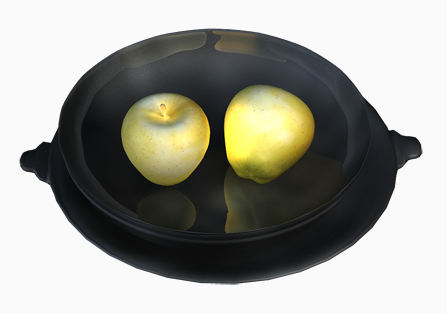Object Descriptions Tower House Parlor
Apples in a silver dish
Many plantations and other estates had orchards for growing apples and other fruits. Examples of orchards recreated today according to early modern designs can be found at Barryscourt Castle, Co. Cork and also in the burgage plot (or backyard property) of Rothe House, Kilkenny (See also the description of the Bawn Area: garden). The Norris estate at Mallow, near Kilcolman, had an orchard, as did the planter William Herbert’s estate at Castleisland, Co. Kerry. Spenser’s orchard, if he had one, would likely have been situated outside of the bawn wall.
Literary Connections
In his sonnet sequence Amoretti (1595), which describes his courtship of his second wife, Elizabeth Boyle, Spenser writes two adjacent sonnets admiring the breasts of his beloved. In the second of the two, 77, he imagines himself dining at a table fit for a prince.

Was it a dreame, or did I see it playne,
a goodly table of pure yvory:
all spred with iuncats fit to entertayne
the greatest Prince with pompous roialty?
Mongst which there in a siluer dish did ly
twoo golden apples of vnualewd price:
far passing those which Hercules came by,
or those which Atalanta did entice.
Exceeding sweet, yet voyd of sinfull vice,
That many sought yet none could euer taste,
sweet fruit of pleasure brought from paradice
By loue himselfe and in his garden plaste.
Her brest that table was so richly spredd,
my thoughts the guests, which would thereon haue fedd.
The table is a metaphor for Elizabeth’s “breast,” or bosom. Spenser’s “thoughts” are imagined as “guests” (not as owners or occupants) who admire “two golden apples” that far surpass those found in mythological accounts. The reader is told that these apples are more wholesome than those that lead “to sinfull vice,” but that depends entirely on the attitude and behavior of those who possess them.
In The Faerie Queene, golden apples have a similar ambiguous status, as both ideal objects to be admired and treasured as well as prized goods tainted with a darker, bloodier hue. In Book II, the Book of Temperance (a book that emphasizes the virtue of resisting the wrong kind of easily proffered fruit), they grow in the Garden of Proserpina: “golden apples glistering bright,/ That goodly was their glory to behold” (FQ II.vii.54.1-2). They are not wholesome: amongst these fruit is the golden apple thrown on Mount Ida by the goddess of Discord. Thus began the chain of events that led to the Trojan War:
Here eke that famous golden Apple grew,
The which emongest the gods false Ate threw;
For which th’Idaean Ladies disagreed,
Till partiall Paris dempt it Venus dew,
And had of her, fayre Helen for his meed,
That many noble Greekes and Troians made to bleed. (FQ II.vii.55.4-9)
Because the Trojan warrior Paris chose the golden apple for Venus, the goddess of Love, he was rewarded by her with the love of fair Helen of Troy: a bitter reward in the end, for it caused discord and bloodshed between the Trojans and the Greeks. A lesson may be drawn here, in that many of the fruits offered to Spenser in Ireland, however beautiful, came with strings attached; his rewards there led to further discord and strife (see also the description of the Garden of Ate in The Faerie Queene IV.i.25).
Bibliography:
Joan Heiges Blythe, “Ate.” The Spenser Encyclopedia. Ed. A. C. Hamilton (Toronto: U of Toronto P, 1990), 76.
Andrew Hadfield, Edmund Spenser: A Life (Oxford: Oxford UP, 2012): 221.
Richard McCabe, Spenser’s Monstrous Regiment: Elizabethan Ireland and the Poetics of Difference (Oxford: Oxford UP, 2002): 77.